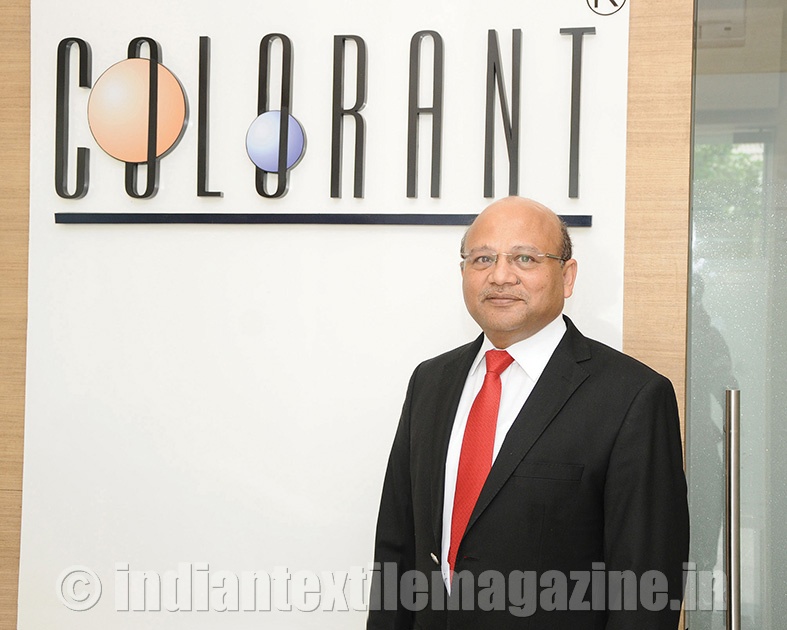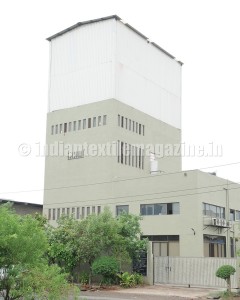Colorant is currently negotiating with a Chinese producer of textile dyes, considered a globally prominent leader in reactive dyes, to set up a joint venture in India to produce dyestuffs.

Colorant Ltd. manufacturing reactive textile dyes was set up in 1999 by the first generation entrepreneur Mr. Subhash Bhargava who, at that time, was working as Marketing (Head) at a major Ahmedabad based producer of dyes and chemicals.
According to him, there was a mini crisis in the dyes industry at that period of time. So he resigned his job and began by trading in dyes for the first few months to get a feel before setting up Colorant by first producing dyes at a leased unit.
With his rich marketing background, Mr. Bhargava had firmly decided that he would brand his products under the name of ‘Colron’ and also offer quality products from day one.
Colorant now produces reactive dyes primarily meant for the cellulose and cotton textile sector and offers the complete range of dyes meeting every need of the industry. Colorant is the first Indian manufacturer and is still the only one producing flourine-based reactive dyes in India, considered a niche segment and is mainly meant for deriving high-light fastness properties in fabrics.
The company operates out of four units in Ahmedabad. One is leased, while the other three are owned by Colorant. Together they employ more than 100 persons and supply products to around 600 customers. The company has an office in Tirupur and sales officials stationed in Vapi, Mumbai, Ludhiana, Delhi, Kolkata, etc.
Colorant has an installed monthly production capacity of 500 tons. Each unit produces a particular dye. “This helps avoid downtimes as machines have to be cleaned when switching production to another quality of dyes,” explains Mr. Bhargava.
The company exports 20 per cent of its production to regions and countries like Brazil, the Central American region, South Africa, Mauritius, Nigeria, Egypt, Iran, Turkey, Pakistan and Bangladesh, and also in small quantities to China which is considered a powerhouse in dyes production.
Mr. Bhargava however laments the fact that Colorant produces only dyes and not dyes intermediates, which he considers a weakness and which became apparent when the industry went through a period of high volatility in the last two years, with prices of intermediates soaring five-fold before returning to the original level again in a few months.
Colorant will now overcome that weakness and is in discussion with a Chinese producer of textile dyes, which is globally the third largest producer of reactive dyes. The Chinese company which also provided flourine-based reactive dyes technology to Colorant will now also supply intermediates. The two companies will together set up a joint venture in India to produce dyestuffs. Alongside, Colorant will also be supplying dyes to the global network of the Chinese company.
Mr. Bhargava says that major global apparel brands like Levis, M&S, Decathlon, etc., have approved Colorant as their vendors. Colorant also expects to be on the list of approved suppliers to the fast fashion brand Zara.
According to Mr. Bhargava, the production processes are meant to be environmentally friendly as the company has installed the latest technology to control environmental pollution and their discharges and meet all pollution control norms set by the Government. However, at the unit where they produce Golden Yellow’s, they are able to reuse all the water that is used during the production process and is a zero-discharge unit for all practical purposes.
Since the Colorant plants were set up after 2000, their outlet norms are 250 COD, while for other old units managed by other companies it is 1,500 COD. So, although they are at a disadvantage vis-a-vis plants set up earlier, they are meeting the set norms for environmental discharge. While the outlet discharge norms of the common effluent plant located in the industrial zone is 600 COD, their discharge is not beyond 250 COD.
He further states that currently they are dealing with 30-35 Government agencies and he expects the Government to reduce these numbers. He also wants the Government to implement GST at the earliest, as he believes it will be a game changer. He also wants environmental policies to be more transparent and rules and regulations simplified.
Highly optimistic about the prospects of the Indian textile industry, Mr. Bhargava cites the saturation of the industry in China. Due to manpower constraints and also higher wages, it will not be able to expand capacity. Also, labour-oriented industries in China will soon be reporting negative growth rates.
All these factors will push the business to other Asian countries like India, Bangladesh, Vietnam, Cambodia, Pakistan and even African countries. He adds that India will be a natural beneficiary of this development with adequate raw material and labour availability at lower costs.
On the textile dyes industry too, Mr. Bhargava shares optimism as he believes that the Chinese Government is no more interested in promoting the sector with its high levels of pollution.
In the case of textile dyes also, he strongly feels that India will be a natural and the only beneficiary as this industry will not move to other countries like Bangladesh, Pakistan or Vietnam. India already has a solid base, being the largest global producer of reactive dyes.
Sharing details of the export markets, Mr. Bhargava states that competition comes mainly from four regions – South Korea, China, India and Europe. Although Korean companies are considered reliable suppliers, they have not been growing since the last four-five years, while China has reached its peak and will start slowing down. The influence of European companies is also coming down fast.
But in the case of India, he remarks that the textile dyes producers have started making inroads into the export markets, due to their being able to offer products meeting the highest quality parameters or at par with those offered by European companies. He also expects reduced influence of producers from other countries.
Colorant also operates an R&D facility which keeps modifying the existing processes in order to cut costs and improve yields by reducing by-products by containing product impurities. This also cuts effluents, thereby generating cost savings. The R&D facility also improves solubility of dyes for the end user.
They are also vendors to state-owned National Handloom Development Corporation (NHDC). However the supply to this agency is taken up more as a corporate social responsibility. According to Mr. Bhargava, orders are received for as less as one kg for different colour dyes from NHDC. This is because NHDC places orders on behalf of a small handloom weaver who needs just 2-3 kg of all colours put together.
As part of its CSR initiated, experts from Colorant, including Mr. Bhargava, deliver lectures and participate in training programs free of cost at various colleges and textile educational institutions. Colorant also provides dyes and literature free to many educational institutions. It also supports education of children of its employees.
Colorant is the recipient of several Export Awards and has won the Award in the last eight years in a row in the SME category from the Gujarat Dyestuff Manufacturers Association (GDMA) and from the Dyestuff Manufacturers Association (India), again in the last four years. It has bagged two Awards from Chemexcil, in the SME exports category.
